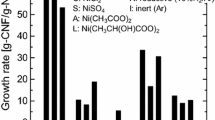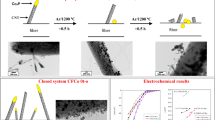Abstract
TiO2 fibers were prepared via alternatively introducing water vapor and Ti precursor carried by N2 to an APCVD (chemical vapor deposition under atmospheric pressure) reactor at ≤200 °C. Activated carbon fibers (ACFs) were used as templates for deposition and later removed by calcinations. The obtained catalysts were characterized by scanning electron microscopy (SEM), transmission electron microscopy (TEM), Brunauer, Emmett and Teller (BET) and X-ray diffraction (XRD) analysis. The pores within TiO2 fibers included micro-range and meso-range, e.g., 7 nm, and the specific surface areas for TiO2 fibers were 141 m2/g and 148 m2/g for samples deposited at 100 °C and 200 °C (using ACF1700 as template), respectively. The deposition temperature significantly influenced TiO2 morphology. The special advantages of this technique for preparing porous nano-material include no consumption of organic solvent in the process and easy control of deposition conditions and speeds.
Similar content being viewed by others
References
Anandan, S., Vinub, A., Venkatachalam, N., Arabindoo, B., Murugesan, V., 2006. Photocatalytic activity of ZnO impregnated Hβ and mechanical mix of ZnO/Hβ in the degradation of monocrotophos in aqueous solution. Journal of Molecular Catalysis A Chemical, 256(1–2): 312–320. [doi:10.1016/j.molcata.2006.05.012]
Caricato, A.P., Capone, S., Ciccarella, G., Martino, M., Rella, R., Romano, F., Spadavecchia, J., Taurino, A., Tunno, T., Valerini, D., 2007. TiO2 nanoparticle thin film deposition by matrix assisted pulsed laser evaporation for sensing applications. Applied Surface Science, 253(19):7937–7944. [doi:10.1016/j.apsusc.2007.02.066]
Huang, Z., Kang, F., Huang, W., Yang, J., Liang, K., Cui, M., Cheng, Z., 2002. Pore structure and fractal characteristics of activated carbon fibers characterized by using HRTEM. Journal of Colloid and Interface Science, 249(2):453–457. [doi:10.1006/jcis.2002.8274]
Imai, H., Matsuta, M., Shimizu, K., Hirashima, H., Negishi, N., 2002. Morphology transcription with TiO2 using chemical solution growth and its application for photocatalysts. Solid State Ionics, 151(1–4):183–187. [doi:10.1016/S0167-2738(02)00708-7]
Kondo, Y., Yoshikawa, H., Awaga, K., Murayama, M., Mori, T., Sunada, K., Bandow, S., Iijima, S., 2008. Preparation, photocatalytic activities, and dye-sensitized solar-cell performance of submicron-scale TiO2 hollow spheres. Langmuir, 24(2):547–550. [doi:10.1021/la702157r]
Liu, Y., Qi, T., Zhang, Y., 2007. Synthesis of hexatitanate and titanium dioxide fibers by ion-exchange approach. Materials Research Bulletin, 42(1):40–45. [doi:10.1016/j.materresbull. 2006.05.013]
Lu, H., Zhang, L., Xing, W., Wang, H., Xu, N., 2005. Preparation of TiO2 hollow fibers using poly (vinylidene fluoride) hollow fiber microfiltration membrane as a template. Materials Chemistry and Physics, 94(2-3):322–327. [doi:10.1016/j.matchemphys.2005.05.008]
Macak, J.M., Schmidt-Stein, F., Schmuki, P., 2007. Efficient oxygen reduction on layers of ordered TiO2 nanotubes loaded with Au nanoparticles. Electrochemistry Communications, 9(7):1783–1787. [doi:10.1016/j.elecom.2007.04.002]
Madhugiri, S., Sun, B., Smirniotis, P.G., Ferraris, J.P., Balkus, K.J., 2004. Electrospun mesoporous titanium dioxide fibers. Microporous and Mesoporous Materials, 69(1-2):77–83. [doi:10.1016/j.micromeso.2003.12.023]
Matsumoto, A., Tsutsumi, K., Kaneko, K., 1992. Titania coating of a microporous carbon surface by molecular adsorption-deposition. Langmuir, 8(10):2515–2520. [doi:10.1021/la00046a027]
Savage, P.E., 2000. Heterogeneous catalysis in supercritical water. Catalysis Today, 62(2-3):167–173. [doi:10.1016/S0920-5861(00)00418-1]
Viswanathamurthi, P., Bhattarai, N., Kim, C.K., Kim, H.Y., Lee, D.R., 2004. Ruthenium doped TiO2 fibers by electrospinning. Inorganic Chemistry Communications, 7(5):679–682. [doi:10.1016/j.inoche.2004.03.013]
Yuan, R., Fu, X., Wang, X., Liu, P., Wu, L., Xu, Y., Wang, X., Wang, Z., 2006a. Template synthesis of hollow metal oxide fibers with hierarchical architecture. Chemistry of Materials, 18(19):4700–4705. [doi:10.1021/cm0609911]
Yuan, R., Fu, X., Liu, P., Wang, X., 2006b. Influence of solvents on morphology of TiO2 fibers prepared by template synthesis. Scripta Materialia, 55(11):1003–1006. [doi:10.1016/j.scriptamat.2006.08.015]
Zeng, H., 2005. Gong Neng Xian Wei (Functional Fibers). Chemical Industry Press, Beijing, p.111.
Author information
Authors and Affiliations
Corresponding author
Additional information
Project (No. 20477006) supported by the National Natural Science Foundation of China
Rights and permissions
About this article
Cite this article
Yang, Hn., Liu, Lf., Yang, Fl. et al. Fibrous TiO2 prepared by chemical vapor deposition using activated carbon fibers as template via adsorption, hydrolysis and calcinations. J. Zhejiang Univ. Sci. A 9, 981–987 (2008). https://doi.org/10.1631/jzus.A0720089
Received:
Accepted:
Published:
Issue Date:
DOI: https://doi.org/10.1631/jzus.A0720089




